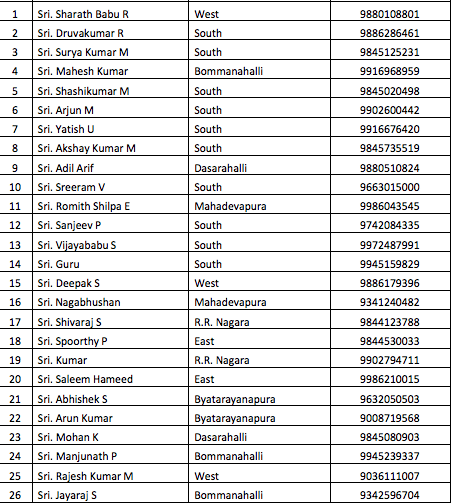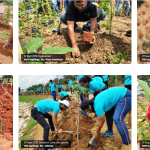By Zahid H Javali
Snake catchers are quite busy this summer, and particularly due to the sporadic rains. The number of snakes being seen in people’s homes and compounds routinely go up during this season. The rains force the species out of their holes. It’s also the mating season for some species, such as the cobras.
“I almost died,” says Nirmala Govindarajan, an author and social sector documentarian, residing in JP Nagar. A few days ago, a 12-day old baby cobra slithered into her house when she had opened the front door while having breakfast. “The snake must have entered the house when I was going back and forth into the kitchen.” At first, she couldn’t make out the snake. She just saw two maroon dots on a near-white foot rug. She dusted it vigorously, flung it on the floor, and was confronted by a vehement hiss, only to be almost eye to eye with a fully-hooded baby cobra. “I was lucky that I ran downstairs and not upstairs. Since I had left my phone behind, I took the help of my neighbours who called a snake catcher. I was later told that baby cobras are far more venomous than adults.” Watch the baby cobra video here.
Until the snake catcher arrived, Nirmala and her neighbours kept watch at a safe distance. The snake kept its hood and continued to stay put on one flight of stairs. Eventually, snake catcher Rohit (aka Rahidas) arrived and took away the snake. He released the baby in the Bannerghatta forest reserve area. “There are three designated ranges, and we release the snakes in certain areas, depending on their proximity,” says Rohit. “Earlier, we used to release the babies in a mini forest in JP Nagar, but now we are not as the density of snakes has become quite high out there. The other areas include the forest areas of Turahalli and Bannerghatta.” In urban areas, snakes are released in open fields and lake beds, such as the island in BTM Layout lake. “While I charge Rs 1000 per snake, I get 4-5 calls from poor people who spot snakes in labour sheds. Such cases are handled for free. And if the snakes are injured, the cost is upon us. The other day, I took an injured snake to a private hospital late at night, and it cost me Rs 3,900.”
This season, the number of snakes being killed are also high. “I am now receiving an average of 20 calls where people have killed snakes spotted in public areas,” says Rohit. “I don’t charge anything if people call me when they spot snakes on the road or a vacant site.” The BBMP rules clearly state that snakes will be rescued only if found inside a house, not inside the compound, road, or vacant site. “But if snake catchers like me don’t attend to such calls, people will kill them. The other day, one snake was caught eating another snake at a rajakaluve (main stormwater drain), far away from people’s homes. But some people stoned it to death.”
Unofficially, there are an estimated 1500 snake catchers in Bengaluru. Most of them are unlicensed and unscrupulous. They charge up to Rs 2000 for every catch. Meanwhile, the Bruhat Bengaluru Mahanagara Palike (BBMP) has designated 26 volunteers for various regions of the city (see the list below). These people are not supposed to charge for their services. However, when we called one such volunteer, Manjunath P, he said, “We charge about Rs 1,000-1500 as sometimes we could be outside the city, and Rs 500 will not even pay for our travel expenses.” When we called People For Animals, they said that they will only rescue snakes in and around Kengeri. However, they did give the number of a person in JP Nagar who could help us with HSR Layout. “Rs 800-1000 is reasonable,” said a person from PFA. “But if someone demands more than Rs 1000, don’t pay them.” He suggested a way to make this happen. “Record the snake catching. Later, when they demand more than Rs 1000, say that you have it all on record and threaten to complain to the BBMP.”
KS Devaraj (49) alias Snake Shivappa claims to have caught 27,700 snakes in the last 21 years (check out his rescues here). He is not on the volunteer list, but charges about Rs 300-500 for every catch. He alleges that since he opposed the unscientific and corrupt ways of the BBMP, he was removed from the list. However, he works with organisations like People For Animals (PFA) to catch snakes in north Bengaluru areas like Jakkur, Yelahanka, and Hebbal. “The poisonous snakes should be left in the forests outside the city, and only the non-poisonous snakes should be allowed to stay within a kilometre of where they were picked up,” he says. “But many unscrupulous snake catchers leave poisonous snakes like kraits, cobras, and vipers within a kilometre from where they were picked up.” While forest officials say that releasing all the snakes in Bannerghatta or Turahalli forest areas will upset the ecological balance, conservationists contend that the snakes should not be displaced from their natural habitat. “The rule now is that we have to release the rescued adult snakes within two kilometres from where they were picked up,” said one PFA volunteer. “However, if the area is densely populated and there are no open fields or grounds, we have to release them beyond two kilometres. But baby snakes cannot survive in the urban areas, and only such snakes are released into the forests.”
You can call Shivappa (Hebbal, Jakkur, RT Nagar) at 99808-55720, Rohit (in and around JP Nagar) at 99649-17651, or People For Animals (Kengeri and around) at 99000-25370, 99803-39880. Or any of the designated BBMP catchers given below.
Snake catchers of BBMP for different zones of Bengaluru





